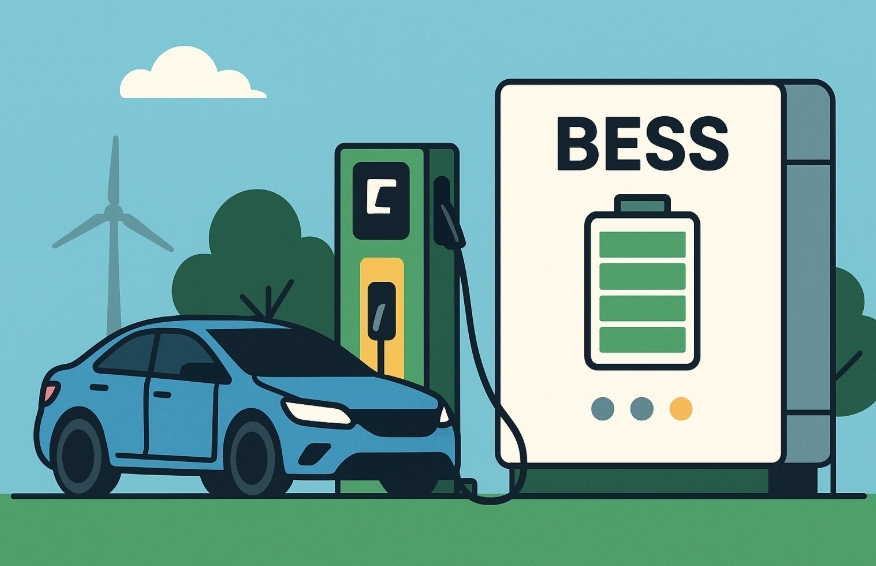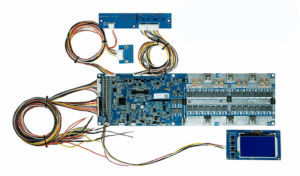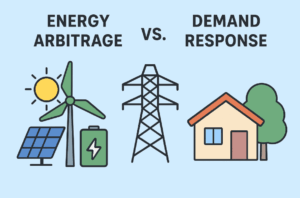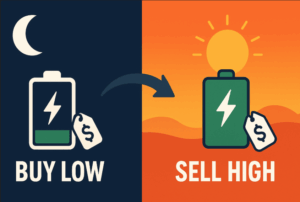- You have no items in your shopping cart
- Subtotal: $0.00

BESS EV Charging Stations: As the world shifts towards electric mobility, the demand for reliable, fast, and eco-friendly EV charging solutions is skyrocketing. One technology making this possible is the Battery Energy Storage System (BESS). By integrating BESS with EV charging stations, we can drastically reduce grid strain, enable ultra-fast charging, and promote the use of renewable energy.
In this post, we’ll break down how BESS is transforming EV charging infrastructure — making it faster, greener, and smarter.
Why Traditional EV Charging Needs a Boost
Most EV charging stations rely entirely on the local electricity grid. When multiple high-powered chargers operate simultaneously, they can cause significant spikes in electricity demand. This leads to:
- Grid congestion and voltage fluctuations.
- Higher peak demand charges for station operators.
- Greater reliance on fossil fuel power during peak hours.
Clearly, there’s a need for a more resilient, efficient approach. This is where BESS comes in.
What is a Battery Energy Storage System (BESS)?
A BESS is a system that stores electricity — often sourced from renewables — and releases it when needed. Think of it as a giant rechargeable battery bank that can charge when power is cheap or green and discharge when demand spikes.
How BESS Powers Faster Charging
One of the biggest concerns for EV drivers is long charging times. High-power chargers (like 150 kW or 350 kW) can deliver ultra-fast charging, but they also require a massive, stable power supply.
By installing a BESS onsite, charging stations can:
✅ Deliver higher charging speeds without needing expensive grid upgrades.
✅ Discharge stored energy instantly to handle peak demand.
✅ Smooth out power fluctuations, providing a consistent experience for drivers.
BESS EV Charging Reducing Grid Strain
When EV charging stations draw large amounts of power from the grid during peak hours, it can overburden local infrastructure. With BESS, operators can store energy during off-peak times or when renewable generation is high, then use that stored energy when demand spikes.
This approach:
- Cuts down peak load charges.
- Minimizes the risk of blackouts.
- Enhances grid stability.
BESS EV Charging Enabling Greener Charging
BESS also plays a vital role in decarbonizing EV charging. By integrating with onsite renewable generation like solar panels or wind turbines, stations can store excess green energy and use it when needed.
Benefits include:
🌿 Less reliance on fossil fuel-generated electricity.
🌿 Lower carbon footprint per charge.
🌿 A truly sustainable EV ecosystem.
BESS EV Charging Use Case: Highway Fast-Charging Hubs
Imagine a busy highway charging hub with dozens of EVs stopping for quick top-ups. Without BESS, this could cause huge demand spikes. With BESS, the station:
- Stores solar energy during sunny hours.
- Uses cheap off-peak grid power at night.
- Provides fast, stable charging even during peak traffic times.
It’s a win-win for drivers, operators, and the grid.
Why BESS is a Smart Investment for Operators
Installing BESS with EV chargers might seem costly upfront, but the long-term benefits are substantial:
💡 Reduced peak demand charges = lower operational costs.
💡 Higher charging capacity = increased customer satisfaction and revenue.
💡 Future-proofing for growing EV adoption and renewable integration.
Key Takeaway
As the EV market continues to grow, traditional charging infrastructure simply won’t cut it. Battery Energy Storage Systems are the missing link that can make EV charging stations faster, more reliable, and greener — all while protecting the grid.
Whether you’re a fleet operator, site owner, or just an EV enthusiast, understanding the role of BESS is crucial for the sustainable future of electric mobility.
FAQs
Q1: How does BESS help in peak shaving at EV charging stations?
Q2: Can BESS be charged with renewable energy?
Yes! Many modern charging stations pair BESS with solar or wind to store clean energy for later use.
Q3: Does BESS make ultra-fast charging more affordable?
Absolutely. By avoiding expensive grid upgrades and peak demand penalties, BESS helps operators provide fast charging at a lower cost.
Final Thoughts
EV charging stations reimagined with BESS are the key to a faster, cleaner, and more resilient electric future. As battery technology advances, expect to see more of these smart charging hubs popping up along highways and in cities worldwide.
🔋⚡ Ready to power up your knowledge? Stay tuned for more insights on how energy storage is driving the green transition forward!




[…] EV charging stations integrate Battery Energy Storage Systems to handle sudden load spikes and keep …. […]
[…] ✅ Electric Vehicles (EVs): Replace fossil-fueled transport with clean alternatives. […]
[…] A C&I BESS helps smooth EV charging loads, reducing peak demand and ensuring consistent charging… This makes it ideal for fleet operators, logistics companies, and commercial charging stations. […]
[…] With the rise of electric vehicles, businesses are increasingly installing charging stations. A C&I BESS helps manage charging loads by reducing strain on the grid and lowering infrastructur… […]